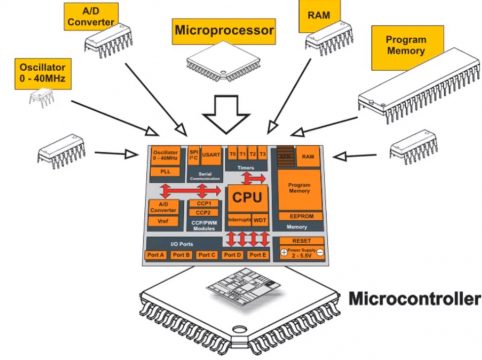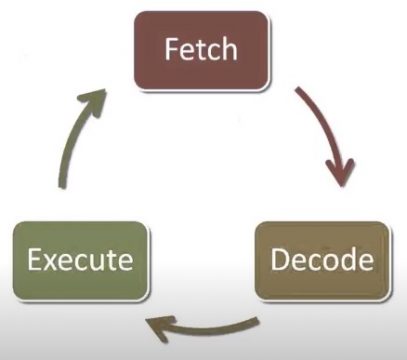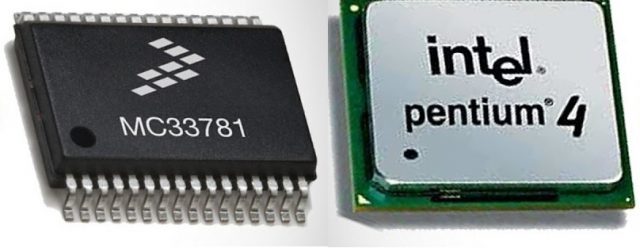Microprocessor history, Working, and compare microprocessor and microcontroller
Table of Contents
Microprocessor Introduction:
Microprocessor is a device which is in the form of single chip and is capable of processing data. A microprocessor is an electronic component that is used by a computer to do its work. It is a central processing unit on a single integrated chip containing millions of very small components including resistors, transistor, and diodes that work together. Microprocessor is the brain of the computer. Microprocessor helps to do everything from writing to searching the data. Everything a computer does is described by lots of the precise instructions and microprocessor carries out these instructions in incredible speed many millions times of a second.
Microprocessor is a multipurpose programmable clock driven resistor based electronic device which basically reads the binary information process the data and gives the output. Imagine you have to function without a brain well it sounds impossible right even while these words are being said they are being registered in to the brain for understanding and processing just like how the brain serves as the function mechanism in our body. A microprocessor serves as the functioning mechanism of a computer. In other words the microprocessor is brain of the computer, mobile phone and other electronic devices that we use in day to day life. Now if someone asks you that whether lights and fans have a microprocessor? Our answer will be NO because they do not require any processing in them. We basically switch it on or off and fan starts rotating. Microprocessor is used in any equipment that requires some sorts of processing to be done from the traffic lights to remote, computer have microprocessor in them. These processors have an algorithm and they work in previously programme manner according to instructions given.
History of the microprocessor:
The invention of the microprocessor takes place about 50 years ago at a young silicon valley start-up called Intel. The first microprocessor was 4004 which was invented in 1971 and it was 4 bit processor. It was soon succeeded by 8008 in 1972 and since then development in microprocessor has been huge back in 2018 Intel release i9-9900K which is 9th generation processor and was claimed to be the fastest gaming processor by Intel in the world at that time.
Microprocessor was invented in the 1970’s for the embedded system. The majority is used still in that way in such things as mobile phones, cars, military weapons and home appliance. Some microprocessors are microcontrollers so small and inexpensive that they are used to control very small products like flash lights and greeting cards that play music when we open it. A few especially powerful microprocessor is used in personal computer.
Our world is dominated by the microprocessor and microcontroller. Microprocessor work with the help of input, output devices and memory so this complete structure form the basic unit of microprocessor. There are some terminologies related to the microprocessor:
Program:
Program is set of instruction required to perform set of operation. These desired operations are to control or mange some external devices. If we have input or output device and we want to control it with microprocessor. The microprocessor will manage this operation with the help of program which is also called software.
The hardware will consist of the basic module of the microprocessor and input output devices and memory. The output of the program is used to control the input and output devices.
Approaches:
We have two approaches to study the microprocessor which are:
- General concept to specific microprocessor
- Specific microprocessor to general concept
General concepts are applicable on all types of microprocessor and based on these concepts we will apply it to the specific microprocessor like 8085 and 8086 microprocessors. Similarly the specific microprocessor concepts are used to find out the general concept. Now to understand microprocessor we will understand 8085 microprocessor.
As we know that the wheels are the most important part of the vehicles and precursor of the industrial revolution because the evolution of the industry is possible due to the wheel. Similarly microprocessor is found in all things surrounding us. Microprocessor is power chip which is used in controlling and monitoring of other devices. Microprocessor is very important for scientists and engineers.
Memory:
Microprocessor has some small inbuilt memory in the form of registers which is extended with the help of extended memory.
Control unit:
The control unit will control the internal and external signals.
Internal structure of the microprocessor:
The internal structure of the microprocessor consists of:
- ALU (Arithmetic logic Unit)
- CU ( Control unit )
- Registers
Each of these has a specific predefined role.
ALU (Arithmetic logic unit):
Arithmetic logic unit perform all the logical and arithmetic calculation on the basis of the data that has been given to it. Mathematical calculations include:
- Addition
- Subtraction
- Multiplication
The logical operations are:
- AND
- OR
- NOT
Registers:
The registers are temporary data storage location in the microprocessor depending upon the need they either hold data or point in the direction where the data is located. Registers are divided in to three categories:
- General purpose registers
- Specific registers
- Memory registers
Depending on the need data can be stored or extracted from them accordingly.
Control Unit:
The control unit which controls the operations in the microprocessor it dictates the how the internal memory of the computer should respond to the given instruction and control the flow of data between the microprocessor and the system.
The microprocessor is further connected with the input devices, memory unit and output devices.
Input devices:
The input devices are used to feed information in to the microprocessor.
Memory unit:
Memory is the internal storage unit of the microprocessor which is commonly known as RAM. This unit stores data and information that is required for processing. It also stores the intermediate results of programming.
Output devices:
The output devices provide the results of the data that has been computed by the processor. The output can be in multiple forms:
- It can be in visual form when we consider the monitor of the computer
- It can be in audible form when we consider the speaker of the computer
Pins of the microprocessor:
Various pins are attached to the structure of the microprocessor. The pins will be used to control the input and output in the form of zeros and ones.
Working of the Microprocessor:
Microprocessor used three steps in its working which are:
- Fetch
- Decode
- Execute
The working of the microprocessor follows a simple fetch decode and execute cycle. In this the microprocessor first fetches the function to be executed from the memory by copying the instruction from the computer memory in to the microprocessor. Now the instruction is present in an encoded form in the memory. Now in the decoded stage the microprocessor figures out what operation the instruction is mean to do. It has been decoded the control unit of the processor then passes these decoded instructions to be executed. In the execution state this operation is performed. This cycle continues till a stop instruction is reached or till the program ends.
Operation of the microprocessor can be very simple like adding two numbers or moving some data from one place another are complicated like copying a series of letters and numbers called strings from one place in the computer memory to the different place.
Microprocessor based instrumentation system:
The combined form of the microprocessor with the output device, input device, memory and other electronic device working together is basically known as microprocessor based instrumentation system. Every instrumentation around a microprocessor where the microprocessor is used to carry the activities like, processing, display or showing the output so these all things are carried by the microprocessor and any instrumentation system center around the microprocessor is known as microprocessor based instrumentation system.
Instrumentation system can be control in to two ways which are:
- Open loop based microprocessor system
- Closed loop based microprocessor system
Open loop based microprocessor system:
If in a physical system there is no any automation of the variation in the output. So the correction of the variation in its output then that is what we have in open loop based microprocessor based system. If microprocessor gives output in form of some display like indicator that may be either lamp, LED or LCD to the human operator and then on the basis of the display information. The human operator makes changes in the necessary system by looking at the indicator given by the microprocessor. This is called open loop based microprocessor system.
Let us consider we are managing pressure condition and in the open loop system we have upper limit of pressure which is 20 and lower level of the pressure. This can be done using programming in the microprocessor. When the pressure will increase the microprocessor will check the value when the present value is increased or decrease from the value programmed in the microprocessor. When the input will be given to the microprocessor it will be converted in to digital form. The microprocessor check for the upper and lower limit and what to show on display the microprocessor will think and it will gives the output to the indicator. The human operator will see this output according to which it operates other system like pressure to be increase or decrease. All the responsibilities will be taken by the human operator.
Compare Microprocessor and Microcontroller:
Difference between microprocessor and microcontroller:
If we see the microprocessor or microcontroller it look similar but there are many differences in many aspects. They are different in term of application in which they are used. They are different in terms of cost. They are different in terms of the processing power which they possess and they are different in terms of the power consumption.
Difference between microprocessor and microcontroller in terms of applications:
Now first we will discuss the differences based on the application in which they are used:
The classic example of microprocessor application is personal computer or laptop. So using the laptop we can do a lot of staff like:
- Gaming
- Web browsing
- Photo editing
- Creating documents
- Mathematical calculation
- Simulation
- Media streaming
The microprocessor is used in the application where the tasks are not predefined it depends upon the user or it is used in application where intensive processing is required.
While in case of microprocessor it is used for the specific task so based on the inputs which are given to the microcontroller it do some processing and it gives the result as an output. So here the input could be a user input or the inputs which are coming from the sensor. So the examples of the microcontroller applications are the:
- Digital camera
- Washing machine
- Microwave oven
In all these devices the task which is going to be performed is predefined. Like a case in microwave oven once we set the power and timing it gives us the cooked food. Likewise in the case of washing machine once we set the parameters of the machine it gives us the clean and dry clothes. So basically a microcontroller is used in the application where the task is predefined.
Difference between microprocessor and microcontroller in terms of internal structure:
The microprocessor can be used for a very light application like creating documents or very intensive application like gaming or media streaming. So the amount of the memory that is required depends upon the application.
A microcontroller chip only consists of CPU which is central processing unit. All the memory elements and the I/O interfaces are connected to it externally. So in case of a microprocessor, memory elements like RAM, ROM, I/O ports, serial interfaces and timers all are externally connected. While in case of microcontroller as they are used for specific task the amount of the memory and the I/O ports which are required limited. So in case of the microcontroller all the memory elements and I/O ports are integrated along with a CPU inside a single chip. So the size of the overall system is much smaller. While in case of the microprocessor as all the memory elements and I/O ports are connected externally so overall size of the system is large than the microcontroller.
Difference between microprocessor and microcontroller in terms of processing:
Microprocessors are operated at much higher speed. If we see the clock speed of the microprocessor it is in the range of the Giga hertz. The clock speed varies from the 1 GHz to the 4 GHz for the high end processor. So as microprocessor has to run an operating system the amount of the memory which is RAM and ROM which is required quite high. RAM which is a volatile memory in the microprocessor it ranges from 512 MB and it goes to 32 GB for high end processors. Similarly if we see the ROM in the microprocessor it ranges from 128 GB and it goes to 2 TB and the common peripheral interfaces we see in the microprocessor is like USB, high speed and the UART. While in the case of the microcontroller the clock speed is in the range of Mega hertz. So if we see the clock speed of microcontroller, it goes from 1 MHz to 300 MHz in the high end microcontrollers. The amount of the memory that is required by the microcontroller is quite less. The RAM in the microcontroller is in the range of kilobytes. So it can go from the 2 KB up to the 256 KB. The flash memory or program memory inside the microcontroller varies from 32 KB and it can go up to the 2 MB. The common peripheral interfaces which we find inside the microcontroller are I2C, SPI and UART. So basically all these are serial interfaces which we find inside the modern day microcontroller.
The modern day microprocessor is 32 bit and 64 bit. The 32 bit microprocessor means that it can handle 32 bits of the binary data at the same time. Similarly 64 bit microprocessor can handle 64 bits of the binary data at the same time. So in a case of 64 bit of microprocessor all the address bus and the data bus are of the 64 bit. Similarly in a case of 32 bit of microprocessor all the address bus and the data bus are of the 32 bit. While in the modern day microcontroller they are either of 8 bits, 16 bits or 32 bits. So the amount of the data which can be handled by a microprocessor in a single cycle is higher than microcontroller.
Difference between microprocessor and microcontroller in terms of power consumption and cost:
In the case of the microprocessor as all the memory elements and I/O ports are connected externally the overall cost of the system as well as power consumption is higher compared to the microcontroller.
The chip find out the smart mobile phone is neither microprocessor nor microcontroller it is the combination of both things.
Applications of microprocessor:
- Medical devices
Blood pressure measurement, blood sugar measurement etc.
- Measuring instruments
Oscilloscope, multimeter, spectrum analyser.
- Music related instruments
- Defence application
Rader, missiles, satellites
- Computers
- Household devices
Microwave oven, toys, washing machine.


